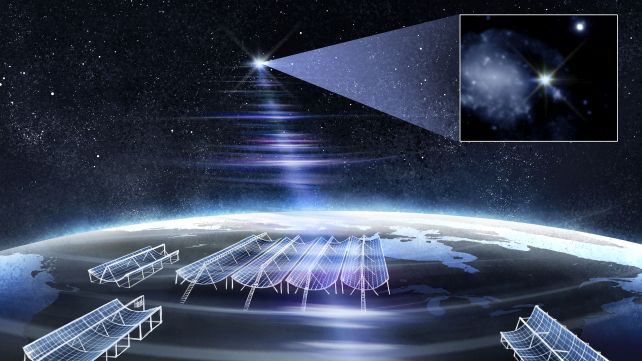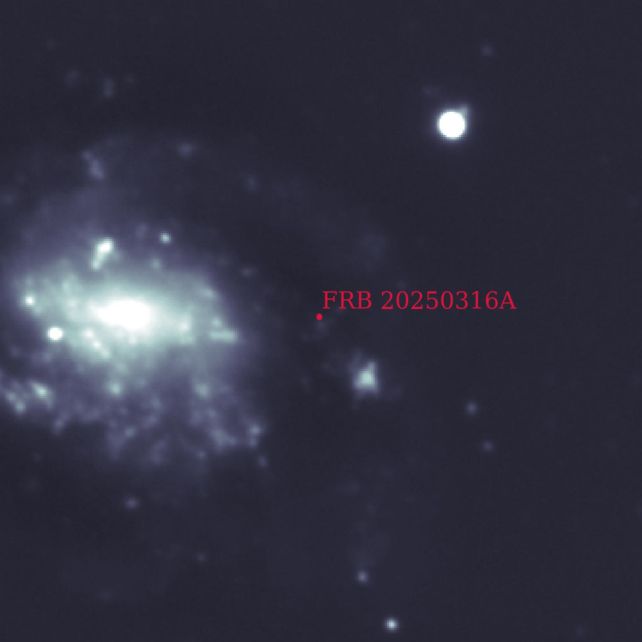A dazzling bolt of radio light from across intergalactic space is the most powerful of its kind seen to date – and its location has been tracked with unprecedented precision.
On 16 March 2025, the CHIME radio telescope in Canada recorded a one-off fast radio burst ( FRB) so powerful, astronomers initially weren't sure about what they were looking at – discharging in mere milliseconds as much energy as the output of the Sun over four days.
It has been named the RBFLOAT, or radio-brightest flash of all time.
Related: Repeating Signals From Deep Space Are Extremely Unlikely to Be Aliens. Here's Why
"It was so bright that our pipeline initially flagged it as radio frequency interference, signals often caused by cell phones or airplanes that are much closer to home," says astrophysicist Wen-Fai Fong of Northwestern University in the US.
"It took some sleuthing by members of our collaboration to uncover that it was a real astrophysical signal."

FRBs are among the more delightful and intriguing mysteries of the Universe. As the name suggests, they are very short-lived, but extremely powerful, pulses of radio waves that blast, seemingly at random, from the depths of space.
Although there can be quite a bit of variation in how they present, FRBs are broadly sorted into two main categories: those that repeat, sometimes on a patterned schedule, and those that flare once and subside, yet to be detected a second time from the same location.
Repeating FRBs can be predicted, triangulated, and studied with relative ease. One-off FRBs are unpredictable and, because they're shorter than an eyeblink, a lot more difficult to trace back to a source galaxy.
To make tracing one-off FRBs less difficult, CHIME has been augmented with smaller, secondary 'Outrigger' telescopes, located at great distances from the core facility in Canada. The addition of more detectors gave the researchers the tools they needed to triangulate the signal, down to a resolution of just 45 light-years.
With the full array of Outriggers online, a team of researchers was able to trace the RBFLOAT (also known as the Root Beer FLOAT, because astronomers like to amuse themselves that way) to the outskirts of a galaxy in the Big Dipper constellation, located at a distance of just 130 million light-years – the closest non-repeating FRB identified to date.

This precision localization meant the scientists could then study the environment from which the FRB emerged in incredible detail, using the MMT telescope and the Keck Observatory to conduct follow-up observations.
This, in turn, helps astronomers narrow down the likely object responsible for the FRB. A growing body of evidence – including an FRB from right here in the Milky Way – suggests that extremely magnetic neutron stars called magnetars are the culprit behind a lot of the FRBs we detect here on Earth.
"The FRB lies on a spiral arm of its host galaxy," says astronomer Yuxin "Vic" Dong of Northwestern University.
"Spiral arms are typically sites of ongoing star formation, which supports the idea that it came from a magnetar. Using our extremely sensitive MMT image, we were able to zoom in further and found that the FRB is actually outside the nearest star-forming clump. This location is intriguing because we would expect it to be located within the clump, where star formation is happening. This could suggest that the progenitor magnetar was kicked from its birth site or that it was born right at the FRB site and away from the clump's center."

A survey of the location using JWST, published as a second paper, supports this interpretation.
RBFLOAT, on its own, is an exciting find. Its extreme brightness, and its proximity to Earth, could yield some significant clues about FRBs. Currently, astronomers are trying to figure out if there are any significant differences between repeating and one-off FRBs; and whether magnetars are the only objects that produce them. Data on individual FRBs is important for interrogating these questions.
But RBFLOAT is one drop in the cosmic ocean – and its detection demonstrates how CHIME just blew open our ability to find other such drops.
"Thanks to the CHIME Outriggers, we're now entering a new era of FRB science," says astronomer Tarraneh Eftekhari of Northwestern University.
"With hundreds of precisely localized events expected in the next few years, we can start to understand the full breadth of environments from which these mysterious signals emanate, bringing us one step closer to unlocking their secrets. RBFLOAT is just the beginning."
The research has been published in The Astrophysical Journal Letters.
